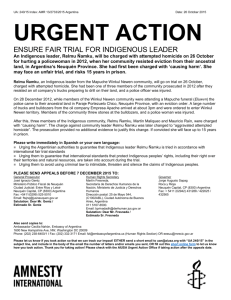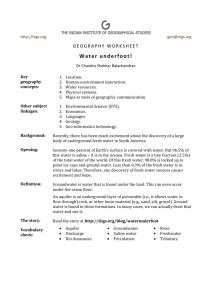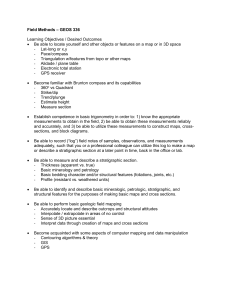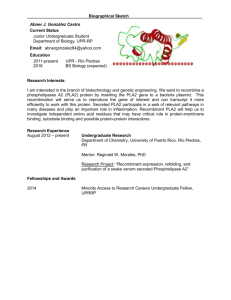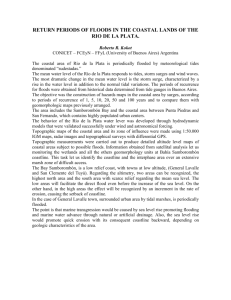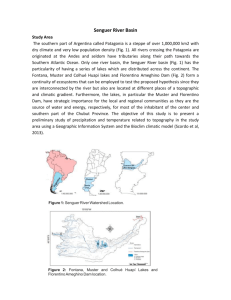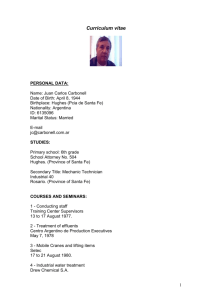the sauropods of the neuquén and chubut groups and their
advertisement
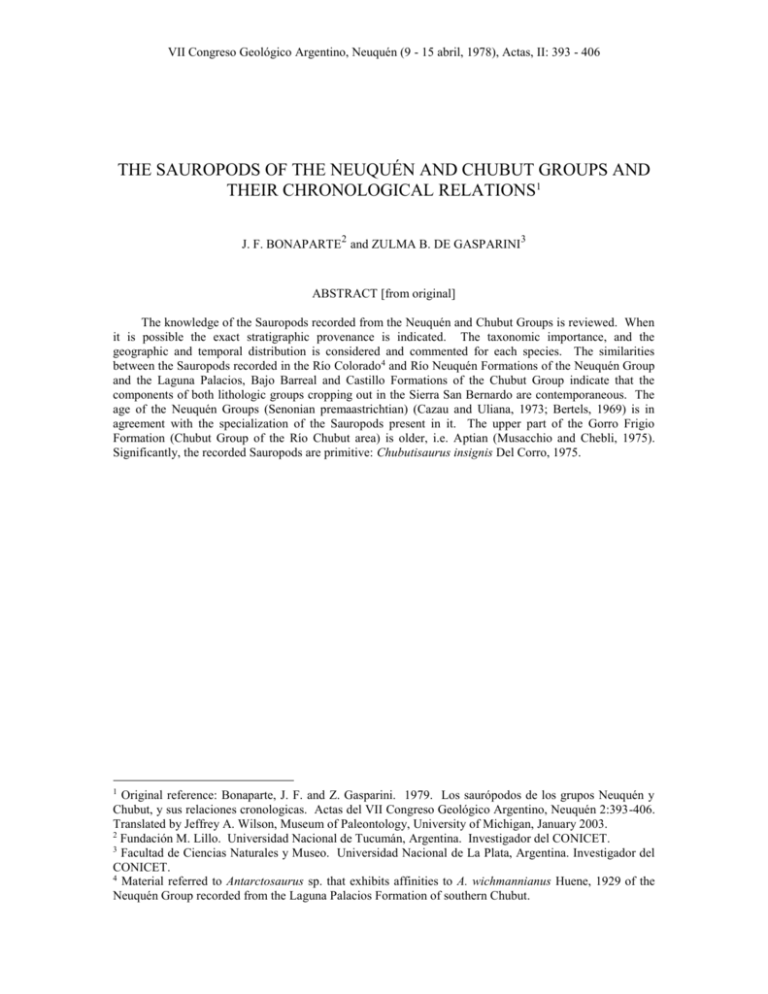
VII Congreso Geológico Argentino, Neuquén (9 - 15 abril, 1978), Actas, II: 393 - 406 THE SAUROPODS OF THE NEUQUÉN AND CHUBUT GROUPS AND THEIR CHRONOLOGICAL RELATIONS1 J. F. BONAPARTE2 and ZULMA B. DE GASPARINI 3 ABSTRACT [from original] The knowledge of the Sauropods recorded from the Neuquén and Chubut Groups is reviewed. When it is possible the exact stratigraphic provenance is indicated. The taxonomic importance, and the geographic and temporal distribution is considered and commented for each species. The similarities between the Sauropods recorded in the Río Colorado4 and Río Neuquén Formations of the Neuquén Group and the Laguna Palacios, Bajo Barreal and Castillo Formations of the Chubut Group indicate that the components of both lithologic groups cropping out in the Sierra San Bernardo are contemporaneous. The age of the Neuquén Groups (Senonian premaastrichtian) (Cazau and Uliana, 1973; Bertels, 1969) is in agreement with the specialization of the Sauropods present in it. The upper part of the Gorro Frigio Formation (Chubut Group of the Río Chubut area) is older, i.e. Aptian (Musacchio and Chebli, 1975). Significantly, the recorded Sauropods are primitive: Chubutisaurus insignis Del Corro, 1975. 1 Original reference: Bonaparte, J. F. and Z. Gasparini. 1979. Los saurópodos de los grupos Neuquén y Chubut, y sus relaciones cronologicas. Actas del VII Congreso Geológico Argentino, Neuquén 2:393-406. Translated by Jeffrey A. Wilson, Museum of Paleontology, University of Michigan, January 2003. 2 Fundación M. Lillo. Universidad Nacional de Tucumán, Argentina. Investigador del CONICET. 3 Facultad de Ciencias Naturales y Museo. Universidad Nacional de La Plata, Argentina. Investigador del CONICET. 4 Material referred to Antarctosaurus sp. that exhibits affinities to A. wichmannianus Huene, 1929 of the Neuquén Group recorded from the Laguna Palacios Formation of southern Chubut. 394 VII CONGRESSO GEOLOGICO ARGENTINO INTRODUCTION The monograph of Huene (1929) on the Cretaceous dinosaurs of Argentina is the only descriptive-comparative study published, in that it analyzes an appreciable volume of material from distinct localities of Patagonia, in great majority coming from what today are recognized as the Neuquén and Chubut Groups. Although we recognize the notable paleontological significance of this work by Huene—especially as it represents the first synthesis of Cretaceous dinosaurs of our country, which is unique in South Americ—we note a failing related to the lack of information regarding the stratigraphic provenance of the material described. In effect, advances in the understanding and stratigraphic determination of the Neuquén (Digrègorio, 1972; Cazau and Uliana, 1973) and Chubut (Lesta and Ferello, 1972; Chebli, 1973; Musacchio and Chebli, 1975; Chebli et al., 1976) Groups have revealed this deficiency. In this work we have taken special care to try to obtain the information necessary to recognize the stratigraphic provenance of the material described by Lydekker (1893), Huene (1929), and Del Corro (1975). In this sense, frequent consults with Drs. M. Uliana (Neuquén Group) and G. Chebli (Chubut Group) have been particularly fruitful. The present contribution attempts to update the significance of the Cretaceous sauropod material from Patagonia, particularly in regard to the validity of the taxa recognized and their eventual utility in stratigraphic correlations. This revision, together with the information provided by our gigantic sauropod material from the Laguna Palacios Formation (Chubut Group) and reconsideration of the work of Del Corro (1975), supports the facts of interest resolves the possible chronological relations between the Neuquén and Chubut Groups. The Sauropods of the Neuquén and Chubut Groups The majority of the sauropod material from the Cretaceous of Patagonia comes from the sediments of the Neuquén in the provinces of Neuquén and Río Negro. The genera recognized are: Titanosaurus (T. australis Lydekker 1893; T. robustus Huene 1929), Laplatasaurus (L. araukanicus Huene 1929), Antarctosaurus (A. wichmannianus Huene 1929), and Argyrosaurus (A. superbus Lydekker 1893). Of the latter, Antarctosaurus and Argyrosaurus are also found in rocks in the Chubut Group (Chubut Province). Chubutisaurus insignis Del Corro 1975, evidently more primitive that the former, was found only in sediments of the Chubut Group in the area near the river of the same name. These genera and their respective species are generally based on incomplete materials that only represent a portion of the skeleton. The referred material, from various geographic locales and within certain stratigraphic limits, have increased the knowledge of the distinct genera and species, but at the same time have raised the question of whether all material assigned corresponds to the species. In this sense, there are important questions that can only be resolved with new discoveries of associated material. Nevertheless, the anatomical differences between the distinct species are evident, so they can be verified with future discoveries that can modify the judgement of this or that material to a species. However, it is improbable that they will demonstrate J. F. BONAPARTE & Z. B. DE GASPARINI, The sauropods of the, etc. 395 any synonymy between the sauropod species described by Huene (1929), except for Campylodon ameghinoi. In our opinion, Campylodon ameghinoi should be considered a nomen vanum. In the following, we treat separately each sauropod species from the Neuquén and Chubut Groups, including their fundamental information and a general commentary. CHUBUTISAURUS INSIGNIS Chubutisaurus insignis Del Corro, 1975. Actas I Congr. Argentino de Paleont. y Bioestratigr. II, 229-235, figs. 1-6. Holotype: Museo Argentino de Ciencias Naturales M.A.C.N. 18.222. An incomplete cervical vertebra, a dorsal vertebra, nine caudal vertebrae, a left humerus, a left femur and “…other limb bones in a good state of preservation.” (Del Corro, op. cit.:230). Geographic origin: 10 km ENE of Cerro Barcino, 50 km north of Los Altares, Paseo de Indios Department, Chubut Province. Stratigraphic and chronological origin: Chubut Group, Gorro Frigio Formation, Cerro Barcino Member; Aptian. Commentary: Del Corro described the material referred to this species in preliminary form, illustrating only a few vertebrae. The validity of the genus and species could be confirmed when more complete material is available that permits a comparative study. It is evident that the primitive character of the amphiplatyan vertebral centra, both in the caudals and in the dorsals. The lack of pronounced opisthocoely in the dorsals and procoely in the caudals clearly differentiates them from the titanosaurs of the Neuquén and Chubut Groups, whose vertebrae are characterized by the presence of these specialized characteristics. As far as the described and illustrated material permits appraisal of characteristics of Chubutisaurus insignis, it is evident that it pertains to a sauropod species more primitive in its organization than the titanosaurs known from Argentina (Lydekker, 1893; Huene, 1929) and Brazil (Arid and Vizotto, 1971). It is very possible that this signifies an older age for C. insignis than that assigned by Del Corro (1975:231), “upper Chubutian (probably Senonian)”; because of which we suggest that its assignment to the Lower Cretaceous is reasonable. Coincidentally, Chebli et al. (1976:383) do not share the criterion for referring the rocks to the Upper Cretaceous. The age of the upper part of the Gorro Frigio Formation (Cerro Barcino Member) has been documented in a study of the ostracods and charophytes (Musacchio and Chebli, 1975) collected in the vicinity of Paso de Indios near the bend of the Río Chubut. These authors (op. cit.:90) interpret “…that the association of Paso de Indios and the associations of the U.S.A. that include similar species, principally the Cloverly and Peterson Formations and other equivalents in the Rocky Mountains” (of Aptian age) “correspond to the same age”. In our opinion, the Aptian age assigned to the levels of the Gorro Frigio Formation containing Chubutisaurus is consistent with the primitive characters of this sauropod. 396 VII CONGRESSO GEOLOGICO ARGENTINO TITANOSAURUS AUSTRALIS Titanosaurus australis Lydekker, 1893. An. Mus. La Plata, Paleont. Argentina. II, pp. 3-8, pls. 1-3; figs. 4, 7. Holotype: Museo La Plata M.L.P. 77-V-28-1. Six caudal vertebrae (Lydekker, 1893:4, pl. 1). Geographic origin: Huene specified that the original material of Lydekker of this species comes from the vicinity of Neuquén “…in the elevated right cliff of the Río Neuquén, some kilometers (2-4) from the railway bridge and in the confluence before Neuquén”. If this provenance is correct, the chronostratigraphic assignments are as follows: Stratigraphic and chronological origin: Neuquén Group, Río Colorado Formation, possibly Bajo de la Carpa Member. Pre-Maastrichtian Senonian. Referred Material: Abundant material corresponding to various individuals, represented in their totality by postcranial skeletons. Geographic, Stratigraphic, and Chronologic origin of the assigned material: 1. Neuquén. Neuquén Group. Material described by Lydekker 1893). Note that Huene (op. cit. 24-25) cited the origin in quotation marks: “Neuquén”. 2. Cinco Saltos, Río Negro Province. Neuquén Group, Río Colorado or Allen Formation. Pre-Maastrichtian Senonian. The majority of material assigned to this species comes from this locality (see Huene, op. cit., 24-25). 3. Facing General Roca, Río Negro Province. Neuquén Group, Río Colorado Formation. Pre-Maastrichtian Senonian. 4. Alarcón, left bank of the Río Limay, Neuquén Province. Neuquén Group. PreMaastrichtian Senonian. Huene (op. cit.) mentioned a vertebra but did not illustrate it. Commentary: In the first place it is evident that the material referred to Titanosaurus (T. australis and robustus) from Patagonia pertains to a genus distinct from Laplatasaurus, Argyrosaurus, and Antarctosaurus. Among other details, because of a very marked difference in the morphology of the humerus, an element preserved in all taxa cited, and in the scapula, also known in all species except Argyrosaurus. Titanosaurus australis was named by Lydekker (1893) on the basis of poor material from Neuquén. Later Huene (1929) confirmed the probable validity of this species from an abundant collection coming from Cinco Saltos, Río Negro Province. Huene indicated in several paragraphs of his monograph (op. cit.: 23, 46, 47) that the material pertaining to different exemplars was mixed. Notwithstanding, as he emphasized, this does not induce very significant errors as those in selecting material of this species for morphological characters of count and proportions. Although these are not infallible, when managed by a paleontologist of the prestige of Huene they deserve a high grade of confidence. In synthesis, T. australis is a species well known by its postcranial skeleton, which requires comparison with new discoveries to confirm some morphological aspects, such as the proportions of the distinct segments of the limbs and cranial characters. Titanosaurus australis is known only from the upper sector of the Neuquén Group, having been documented in some of the fossi- J. F. BONAPARTE & Z. B. DE GASPARINI, The sauropods of the, etc. 397 liferous localities of this geological group. Its absence in other localities of the same group as well as in the Chubut Group may have arisen from defects of the record, or ecological requirements of the species. TITANOSAURUS ROBUSTUS Titanosaurus robustus Huene 1929. An. Mus. La Plata, Paleont. III, 2nd series, pp. 48-53, figs. 11, 12; pls. 18-21. Lectotype: M.L.P. 26-250 right ulna (C.S. 1095); M.L.P. 26-251 left ulna (C.S. 1094); M.L.P. 26-254 left radius (C.S. 1171); M.L.P. 26-259 left femur (C.S. 1480). The initials “C.S.” refer to Cinco Saltos, their origin as figured by Huene (1929). Geographic origin: Cinco Saltos, Río Negro Province. Huene (op. cit., 5) mentioned that “…the site was situated on the railway line north of Cipolletti, in the valley of the Río Neuquén”. This origin is not very precise. Stratigraphic and chronological origin: Neuquén Group, Río Colorado or Allen Formation. Pre-Maastrichtian Senonian. Referred Material: Important quantity of postcranial remains from Cinco Saltos (in majority) and Rancho de Avila. In Cinco Saltos, material of T. australis and T. robustus are encountered. Huene (op. cit.:48) considered that the cervical and dorsal vertebrae of C.S. of the Series 2 (op. cit.: 25) correspond to T. robustus. Geographic, Stratigraphic, and Chronologic origin of the assigned material: 1. Cinco Saltos, Neuquén Province, Neuquén Group, Río Colorado or Allen Formation. Pre-Maastrichtian Senonian. 2. Rancho de Avila (Alamitos), Río Negro Province, Neuquén Group, Río Colorado Formation. Pre-Maastrichtian Senonian. Commentary: The lack of a holotype in the descriptions of Huene has imposed us to designate a lectotype, based on four skeletal pieces that apparently pertain to the same individual. With the evidence available to us it should be admitted that T. robustus is a distinct species from T. australis. The differences are appreciated especially in the robustness of the ulna and in the distinguishing characters listed by Huene (op. cit.: 49-50) referring to the ulna and radius, which are in general valid. Also the femur of T. robustus, with a more prominent and defined greater trochanter than in T. australis, is an element that confirms the validity of the species. It is important to emphasize, nonetheless, that the knowledge of the genus Titanosaurus, registered in Europe, India, and South America is far from being complete and satisfactory. For this it should been interpreted that the diverse species that it integrates may or may not be confirmed the day that new material demonstrates the ranges of morphological variation. T. robustus has been recorded only in two localities in the Neuquén Group: Cinco Saltos and Rancho de Avila, both in Río Negro Province. Until, it has not been registered in the Chubut Group. 398 VII CONGRESSO GEOLOGICO ARGENTINO ARGYROSAURUS SUPERBUS Argyrosaurus superbus Lydekker, 1893. An. Mus. La Plata. Paleontología. Argentina, II, pp. 9-12, pl. 5; figs. 1-1A. Holotype: Museo La Plata M.L.P. 77-V-29-1. Articulated left forelimb composed of a humerus, radius, ulna, one or two carpal bones, and five metacarpals. Geographic origin: Left bank of the Río Chico, near the Pampa Pelada, to the northeast of Lake Colhué-Huapi, Chubut. Stratigraphic and chronological origin: Chubut Group, probably Bajo Barreal Formation. Pre-Maastrichtian Senonian. Assigned material: The assigned material comes from 8 localities, some of which do not correspond to the provinces of Chubut and Neuquén mentioned thus far. For this reason, they are listed with geographic, stratigraphic, and chronologic provenance. 1. An anterior caudal vertebra (Huene, 1929:79). West bank of Lake Colhué-Huapi, Chubut Province. Chubut Group, Castillo Formation or Bajo Barreal Formation. PreMaastrichtian Senonian. 2. Two caudal vertebrae “…of the region of Neuquén” (Huene op. cit.:7). Geographic and stratigraphic provenance unknown. 3. An incomplete femur (Lydekker, 1893, pl. 5, 2; Huene, 1929:80, pl. 38, 1). To the south of the bend of the Río Sengerr, Chubut Province, probably Bajo Barreal Formation. Pre-Maastrichtian Senonian. 4. An incomplete right femur (Huene, op. cit.:80, pl. 38, 2). Near the railroad bridge over the Río Neuquén, Neuquén Province. Neuquén Group, Río Colorado Formation, perhaps Bajo de la Carpa Member. Pre-Maastrichtian Senonian. 5. A complete right femur (Huene, op. cit.:80-81, pl. 38, 3). Sierra San Bernardino, 45 km west of Colonia Sarmiento, Chubut Province. Chubut Group. Bajo Barreal Formation. Pre-Maastrichtian Senonian. 6. A humerus of a juvenile individual, referred with doubts to Argyrosaurus (Huene, op. cit.:81, pl. 37, 6). Probably from Neuquén. Uncertain geographic and stratigraphic provenance. 7. A left humerus, referred with doubts to Argyrosaurus superbus Huene, op. cit.:81, pl. 37, 4). Left margin of the Río Uruguay, near Colón, Entre Ríos Province. ?Asencio Formation. Upper Cretaceous. 8. Caudal vertebrae (Huene, op. cit.:79). To the east of the Río Leona, between lakes Viedma and Argentino, Santa Cruz Province, Upper Cretaceous (Dibenedetto, pers. comm.). Commentary: The validity of this species is based principally on the characters of the robustness of the humerus and to a lesser extent on the bones of the antebrachium. This characteristic, which involves its own morphological traits, differentiates A. superbus from the rest of the sauropods from the Cretaceous of Patagonia. The isolated bones of the hindlimb assigned to this species coincide in being heavy and robust. Nevertheless, for the moment it cannot be affirmed whether they pertain to A. superbus, but neither can it be denied that this robustness is not observed in the species of Titanosaurus, Laplatasaurus, or Antarctosaurus. J. F. BONAPARTE & Z. B. DE GASPARINI, The sauropods of the, etc. 399 The holotype comes from sediments of the Chubut Group, relatively near Lake Colhué-Huapi. Of the material assigned, the most significant comes from the area of Sierra San Bernardo and of the Neuquén Group. Although it is certain that the most interesting material registered in the Neuquén Group, an incomplete femur, is not final evidence of the presence of A. superbus, the morphological characters preserved are undoubtedly comparable to the femora of Sierra San Bernardo illustrated by Huene (op. cit., pl. 38, 1, 3). Or it could be that we have before us a taxon common to the Chubut and Neuquén Groups represented by these femora that, as in the interpretation of Lydekker (1893, pl. 5, 2) and Huene (op. cit., pl. 38, 1-3), could very well pertain to Argyrosaurus superbus. We think that this question requires verification, but we admit that the available evidence is very significant in showing a common taxon in both geological groups. LAPLATASAURUS ARAUKANICUS Laplatasaurus araukanicus Huene, 1929. An. Mus. La Plata, Paleont. III, 2nd Series, pp. 53-66, pls. 22-27. Lectotype: M.L.P. 26-306 right tibia (C.S. 1128) and right fibula (C.S. 1127) illustrated by Huene (1929:pl. 27, figs. 1, 2). The initials C.S. corresponds to Cinco Saltos, identification with which was figured in the work of Huene. Geographic origin: Cinco Saltos, Río Negro Province (see Titanosaurus robustus) Stratigraphic and chronological origin: Neuquén Group, Río Colorado or Allen. Pre-Maastrichtian Senonian. Referred Material: Numerous remains from the postcranial skeleton, especially from Cinco Saltos and Rancho de Avila (Alamitos), Río Negro Province). Huene (op. cit.) assigned to this species material that Lydekker (1893) referred to Titanosaurus australis (op. cit., pls. 2, fig. 4; 4, figs. 1, 3). Geographic, Stratigraphic, and Chronologic origin of the assigned material: 1. “Neuquén”. Neuquén Group. Upper Cretaceous, (material of Lydekker, 1893). 2. Cinco Saltos, Río Negro Province, Neuquén Group, Río Colorado or Allen Formation, Pre-Maastrichtian Senonian. 3. Vicinity of General Roca, Río Negro Province. Neuquén Group, probably Río Colorado Formation. Pre-Maastrichtian Senonian. 4. Rancho de Avila (Alamitos), Río Negro Province, Neuquén Group, probably Río Colorado Formation. Pre-Maastrichtian Senonian.. 5. Río Neuquén. Two km north of the railway bridge, on right bank. Neuquén Group, Río Colorado Formation, possibly Bajo de la Carpa Member. Pre-Maastrichtian Senonian. Commentary: The knowledge of the species is based exclusively on material from the Neuquén Group (Neuquén and Río Negro Provinces), except that cited by Huene (1929:6) in which he refers to Laplatasaurus araukanicus from Sierra San Bernardino (Chubut Province) (“discovered by Riggs”). This 400 VII CONGRESSO GEOLOGICO ARGENTINO material was not numbered or described and is probably deposited at the Field Museum of Chicago (USA). Because of the lack of a holotype, we have designated the lectotype for this species – a right tibia and fibula of the same individual, from Cinco Saltos, Río Negro . Both pieces are characterized by being gracile and slender, traits that differentiate them clearly from those of Titanosaurus and partially from Antarctosaurus. Nevertheless, the fibula of Laplatasaurus is quite distinct from that of Antarctosaurus in the characters of the anterolateral process, as was emphasized by Huene (op. cit.: 62), in having two ridges formed by distinct osseous rugosities, while Antarctosaurus has only one ridge formed by two bony rugosities. The scapula of Laplatasaurus (Huene op. cit.: 2, pl. 23) is clearly different from that of Titanosaurus, and to a lesser degree from Antarctosaurus. The humerus (Huene op. cit., pl. 23, fig. 4), with its distal extreme little expanded, is visibly distinct from that of Titanosaurus, Antarctosaurus, and Argyrosaurus. On the basis of the noted differences we think that the validity of this genus and species is well documented. A difficult problem to resolve, as many discoveries do not pertain to associated and sufficiently complete material, consists in that we ignore whether the totality of material assigned to Laplatasaurus araukanicus corresponds to the same genus and species, or if it corresponds to forms not known at the present. For the most part, the genus and species are mostly endorsed by characters of the lectotype. ANTARCTOSAURUS WICHMANNIANUS Antarctosaurus wichmannianus Huene, 1929. An. Mus. La Plata, III 2nd series, pp. 66-75, pls. 28-35. Holotype: Museo Argentino de Ciencias Naturales M.A.C.N. 6.804. An incomplete skull and mandible, rib fragment, an incomplete right humerus, a distal fragment of the ulna, distal fragments of two radii, two incomplete metacarpals, an ungual phalanx, a right ischium, a distal fragment of a pubis, a left tibia, a fragment of a right fibula, a left calcaneum, various pedal phalanges, a posterior cervical vertebra, a left scapula and a fragment of a right ulna, a proximal fragment of a radius, six incomplete metacarpals, a phalanx, a posterior fragment of an ilium, an incomplete left ischium, a left femur, a left fibula, four or five left metatarsals. All elements pertain to the same individual. Geographic origin: In front of General Roca, on the southern coast of the Río Negro, Río Negro Province. Stratigraphic and chronological origin: Neuquén Group, Río Colorado Formation, probably Bajo de la Carpa Member. Pre-Maastrichtian Senonian. Material Referred to Antarctosaurus cf. A. wichmannianus: A right femur and a left tibia (Huene, 1929:74, figs. 33, 34). Collection of the Field Museum of Chicago, United States of America. Geographic, Stratigraphic, and Chronologic origin: Sierra San Bernar- J. F. BONAPARTE & Z. B. DE GASPARINI, The sauropods of the, etc. 401 do, 45 km west of Colonia Sarmiento. Chubut Group, Castillo or Bajo Barreal Formation. Pre-Maastrichtian Senonian Commentary: The abundant material of the holotype pertains, according to available evidence (Wichmann, 1916; Huene, 1929) to one single individual. Nevertheless, among the material collected from this place are some bony elements that Huene did not attribute to A. wichmannianus because of their proportionally small size. From the Chubut Group, outcropping in the are of the Sierra San Bernardo, comes a femur and tibia that Huene referred with doubts to this species, although he noted that “the tibia has the same conformation and the same proportions as that described from Roca” (1929:75), obviously referring to the holotype material. According to the available evidence, the genus and species are valid by our judgement. The fundamental osteological characters clearly differentiate it from Titanosaurus. These are of a significance that probably correspond to distinctions at the subfamiliar or familiar level. The strong differences in the scapula, humerus, fibula, etc., support this hypothesis. On the other hand, the similarities with Laplatasaurus are greater, although its distinction at the generic level are evidenced by differences in the acromial region and the posterior margin of the scapula, in the distal half of the humerus, the morphology of the metacarpals, and particularly in the distinct comformation of the tuberosities of the anterolateral process of the fibula. The study of the braincase, both mandibles, and their dentition demonstrate affinities with Diplodocus (Upper Jurassic of North America). These similarities could be considered the product of adaptive convergence in distinct lineages and epochs. CF. ANTARCTOSAURUS GIGANTEUS cf. Antarctosaurus giganteus Huene, 1929. An. Mus. La Plata, Paleont. Argentina. III, 2nd series, pp. 75-78, pls. 36; figs. 1-2. Holotype: M.L.P. 26-316, two femora, two imcomplete pubes, incomplete distal extreme of a tibia, indeterminate fragments of six long bones, rib fragments, and two distal caudal vertebrae. Geographic origin: Aguada del Caño, some 22 km west of Neuquén, Neuquén Province. Stratigraphic and chronological origin: Neuquén Group, probably Río Neuquén Formation, ?Plottier Member. Pre-Maastrichtian Senonian. Commentary: The description and comparisons made by Huene (op. cit.) are very clear. Its affinities with Antarctosaurus [wichmannianus] are very significant, although not sufficient to refer it with certainty to the same [species]. They can be differentiated by its [A. wichmannianus] more gracile construction, with a proportionately slender diaphysis. In the opinion of Van Valen (1969), A. giganteus is the largest species of dinosaur registered. This same author has suggested that A. wichmannianus and A. giganteus are growth stages of the same species as they are “from the same strata”, translated from Van Valen (1969:624). However, the actual statigraphic occurrence indicates that A. wichmannianus comes from the Río Colorado Formation, whereas A. giganteus very probably comes from the Río Neuquén Formation. In that same 402 VII CONGRESSO GEOLOGICO ARGENTINO paper, Van Valen chose the name A. giganteus to include the material of the two species of Antarctosaurus. This is objectionable because A. wichmannianus has priority not only for having been described in earlier pages, but also for being based on better material. Nevertheless, in our opinion both A. wichmannianus and A. giganteus are valid species, and the stratigraphic evidence indicates that they were not contemporaries. ANTARCTOSAURUS SP. Antarctosaurus sp. Material under study. Holotype: The material under study pertains to the collections of vertebrate paleontology of the Fundación M. Lillo, Tucumán. It is material of an associated individual: a right scapula, a right humerus, right radii and ulnae, a pubis, an incomplete right femur, an incomplete left tibia, an incomplete fibula, an astragalus, two caudal vertebrae, and various rib fragments. Geographic origin: Between the bend of the Río Sengerr and the Río Pampa of María Santísima, in Chubut Province. Stratigraphic and chronological origin: Chubut Group, lower part of the Laguna Palacios Formation. Pre-Maastrichtian Senonian. Commentary: The material is under study by J. Bonaparte. It is a series of exceptionally complete pieces that pertain to one individual. They were discovered by a commission of the Fundación M. Lillo and the Universidad Nacional de Tucumán in January, 1976. Undoubtedly corresponding to Antarctosaurus, its assignment to Antarctosaurus sp. is provisional until detailed comparisons determine whether it pertains to A. wichmannianus, the species known from the Neuquén Group. CAMPYLODON AMEGHINOI Campylodon ameginoi Huene, 1929. An. Mus. La Plata, Paleont. Argentina, III, 2nd series, pp. 82-83, pls. 40; figs. 1, 2. Holotype: An incomplete left maxilla with seven alveoli, in one of these there is a tooth and one replacing; there is also an isolated broken crown. Geographic, Stratigraphic and chronological origin: Western flank of the Sierra San Bernardo, to the west of Lago Musters. Chubut Province, Chubut Group, Castillo, Bajo Barreal, or Laguna Palacios Formation. Pre-Maastrichtian Senonian. Commentary: The material on which the genus and species are based is truly poor, as the maxilla is incomplete on all its margins except the alveolar margin. It pertains to a sauropod whose dental characters, as is possible to analyze with the fragmentary materials available, appear “…intermediate between the spatulate form of Camarasaurus and the pencil-like form of Diplodocus” (Huene, 1929:83). Nonetheless, Huene later underscores that J. F. BONAPARTE & Z. B. DE GASPARINI, The sauropods of the, etc. 403 the character of those “resembling in some ways that of Antarctosaurus wichmannianus by its roughened surface5…”. The diagnostic characters of all the sauropods of Patagonia are based on the morphology of the postcranial skeleton, principally the appendicular bones, simply because it rare to find cranial material of any significance. Under these circumstances, it is inadvisable to propose a new genus and species on an incomplete maxilla without basis of comparison; it could well correspond to one of the genera known only from postcranial skeletons (e.g., Argyrosaurus superbus). For this reason and for the peculiarities of this maxilla cited by Huene (op. cit.:109), we consider Campylodon ameghinoi to be a nomen vanum. DISCUSSION Paleobiological Aspects It is evident that the restudy of material and the taxonomic assignments of Huene (1929), a work in which was revised those described by Lydekker (1893), do not offer a rigorously stable framework of the relationships between the discoveries from different places, many being incomplete and others mixed. Nonetheless, the degree of confidence in demonstrating two fundemental aspects is worth pondering: a) The existence of various sauropod genera and species; b) the existence of an associationof sauropods from the same level of organization, with some species similar and common in the Neuquén and Chubut Groups (area Sierra San Bernardo). This brings attention, then, to the geopaleontological literature of recent years that ignores the detailed and well illustrated work of Huene (1929), an author who has been recognized as the major dinosaur specialist of the century (Romer, 1968:136). The work of Huene on the Cretaceous dinosaurs of Argentina is, to our judgement, basically correct, and its adaptation to the modern stratigraphic evidence brings into effect, in a large way, its power. The fauna of “titanosaurs” in the Neuquén and Chubut Groups (area of Sierra San Bernardo) shows a marked radiation of these large sauropods, in that they include diverse genera and species, and others of gigantic size, like A. giganteus, with femora 2.22 m and 2.31 m long. Keeping in mind the numerous discoveries, published and unpublished – among the latter including some of great interest (Casamiquela, pers. comm.) – it can be said that Patagonia is the region in the southern hemisphere where has been discovered the best evidence of this sauropod fauna. “Titanosaurs” have been registered in North America, Europe, India, Africa, diverse areas in South America (Brazil, Arid, 1967; Arid et al., 1962; Arid and Vizotto, 1971; Chile, Casamiquela, Corvalán and Francesca, 1969; Argentina, northeast area, Bonaparte and Bossi, 1967; Bonaparte, in prep.), and in Patagonia.. The lattermost is the area that has thus far produced the largest quantity and variety of material. The radiation of the “titanosaurs” and their dispersal has been verified in the Upper Cretaceous (Charig, 1973:346). Huene’s (1929:83) phrase ‘superficie de asperezas’ was misquoted by B & G as ‘superficies de esperezas’; the year was also misreferenced as 1919. [Tr.] 5 404 VII CONGRESSO GEOLOGICO ARGENTINO Stratigraphic Aspects The analysis of the Cretaceous sauropods of Patagonia permits recognition that: 1. Chubutisaurus insignis Del Corro 1975 is the most morphologically primitive species, accordingly it is the oldest of the Cretaceous sauropods of Patagonia. The preceding is based on the amphiplatyan caudals and probably dorsals of this species, and in the chronological results obtained by Musacchio and Chebli (1975) from the study of ostracods and charophytes from the same geological unit that produced Chubutisaurus. 2. Argyrosaurus and Antarctosaurus were registered from the Castillo, Bajo Barreal, and Laguna Palacios Formations of the Chubut Group, area Sierra San Bernando, and the Río Colorado Formation of the Neuquén Group, which suggests very similar ages from the units specified. 3. The sauropods from the Río Neuquén, Río Colorado, and Allen Formations of the Neuquén Group, and the Castillo, Bajo Barreal, and Laguna Palacios Formations of the Chubut Group indicate the very probable chronological correlation between these sections of both geological groups. 4. The presence of large sauropods in the Castillo, Bajo Barreal, and Laguna Palacios Formations in the southern extreme of the Sierra San Bernardo and vicinity indicates a close geological age between these three entities. Chronological Aspects The chronological focus of this theme presernt two basic coincident aspects: a) The pre-Maastrichtian Senonian age of the Neuquén Group (Cazau and Uliana, 1973; Bertels, 1969) b) The Upper Cretaceous age attributed to the assocations of large titanosaurian sauropods in distinct parts of the world (Huene, 1929, 1956; Romer, 1966, 1968; Charig, 1973). In this way, the geological map of Neuquén is coherent, by coincidence of the geological information (Intersenonian discordance at the base of the group); of microfossils coming from its roof (Jagüel Formation) studied by Bertels (1969), which indicate lower and middle Maastrichtian; and the sauropods from the Río Neuquén, Río Colorado, and Allen Formations, which indicate the Senonian (sensu lato) age proposed by Huene (1929), whose we opinion we express in this paper. In relation to the Chubut Group (area of Sierra San Bernardo), the existent geological map is not coherent. Although diverse references in the literature coincide in assigning to the Upper Cretaceous the formational units of this typical region of the Chubut Group (Huene, 1929; Feruglio, 1949; Menéndez, 1959; R. González, 1971), the works of Lesta and Ferello (1972), based fundamentally on regional stratigraphic correlations, J. F. BONAPARTE & Z. B. DE GASPARINI, The sauropods of the, etc. 405 have substantially modified the former chronological interpretation. The stratigraphic scheme of these authors, which they expressly considered provisional, indicates that the Cretaceous units outcropping in the region of Sierra San Bernardo occupying the Valenginian-lower Senonian interval, that is, they span the better part of the Cretaceous. Chebli et al. (1976) interpreted the age of the Chubut Group, to the east of Paso de Indios, as spanning the Barremian-Aptian interval (in part), an interpretation that by extension modified the opinion of Lesta and Ferello (1972). The information that the sauropods of the Chubut Group (Sierra San Bernardo) offer us is coincident with the earlier chronological ideas of Lesta and Ferello (op. cit), which we cited above. They indicate to us that the Castillo, Bajo Barreal, and Laguna Palacios Formations have should have an age equal or very close to that of the Río Neuquén, Río Colorado, and Allen Formations, as they contain a sauropod fauna of similar grade of organization. That is, that the available evidence of the sauropod dinosaurs essentially confirms the Senonian age suggested by Huene (1929) for the taxa from the zone of Sierra San Bernardo, which coincides with that assigned by Menéndez (1955) to the flora of Co. Cachetamán (Castillo Formation). This does not discard, naturally, some adjustment of this chronological assignment that be found on the basis of better material. With respect to Chubutisaurus insignis, excavated from the Gorro Frigio Formation (Cerro Barcino Member), fromwhose levels Musacchio and Chebli (1975) obtained microfossils of Aptian age, results in its anatomical condition more primitive than the other sauropods from Sierra San Bernardo and of the Neuquén Group. Because of this, we think it reasonable to admit that between the Gorro Frigio Formation (Chebli et al., 1976) and the Castillo Formation of the area of the Sierra San Bernardo there should exist a hiatus of some magnitude, eventually spanning part of the Albian until the Turonian inclusively. That is, that the Chubut Group outcropping in the region to the east of Paso de Indios is somewhat older than the section of the Chubut Group outcropping in the Sierra San Bernardo. Acknowledgements One of the authors, JFB, thanks the National Geographic Society for paying for two exploratory paleontological trips to the Cretaceous of Patagonia. Both authors acknowledge Dr. Gualter Chebli and Miguel Uliana of Yacimientos Petrolíferos Fiscales for valuable information on the stratigraphy of the levels containing the material analyzed. LIST OF WORKS CITED IN THE TEXT [see original for references] 406 VII CONGRESSO GEOLOGICO ARGENTINO [additional references]
